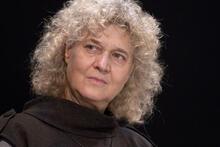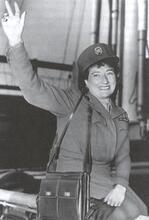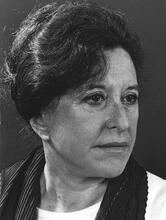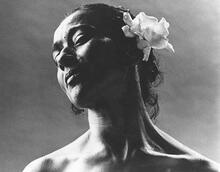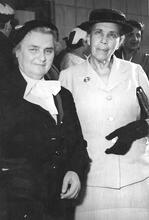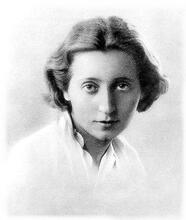Claire Epstein
Claire Epstein is an outstanding example of a spirited woman archaeologist who worked untiringly and out of true love in search of the past in the Land of Israel. Born in London in 1911, Epstein began her archeological career in Israel in 1952 and made major strides in the field throughout her career. The crowning achievement of Epstein’s career was her discovery of the culture of the Chalcolithic period in the Golan. She received many honors throughout her career including the Israel Prize in 1995 for archaeology and the Israel Museum’s Percia Shimmel Award in Archaeology in 1985.
Early Life and Education
Claire Epstein was born in London on September 18, 1911, to an upper-class Anglo-Jewish family. Her father, Mordecai Epstein (born Manchester, c. 1890–d. 1946), the son of parents who had migrated from Latvia, was editor of The Statesman’s Yearbook. In 1910 he married Olga, née Oppenheimer (b. Germany 1890?–d. 1971), whose parents had migrated from Germany when she was a child. Olga, a homemaker, was active in WIZO and also in saving Jews from Germany prior to and during World War II. In addition to Claire, they had two sons: Edward Nathaniel, born in 1915, who died in 1992, and (Sir) Anthony, born in 1919.
After attending the progressive King Alfred School in Hampstead, Claire studied Italian at University College, London, spending a year in Perugia as part of her studies. She gained a B.A. degree in 1932. In 1937 she immigrated to Palestine, joining the British Army in World War II. Upon demobilization she joined A voluntary collective community, mainly agricultural, in which there is no private wealth and which is responsible for all the needs of its members and their families.kibbutz Ein Gev on the eastern shore of Lake Kinneret, but some time later moved to Kibbutz Ginossar on the opposite shore, remaining a member there until her death.
Early Excavations
Epstein’s first experience in archaeology was at an excavation at Sussita, located on a hill above Ein Gev. In 1952 she joined the team excavating at Tel Hazor in the Upper Galilee, headed by Professor Yigael Yadin. Here she worked in several areas: in the lower city of Tel Hazor she worked at Area D on buildings and graves of the Middle Bronze Period IIB and the later Bronze Period I. She then joined the team digging at Area H, the large site of temples from the Second Middle Bronze IB Period (1705–1550 b.c.e.), particularly because she happened to chance on these temples. She also excavated at Site Area A in the upper city of the Tel, where important relics of the Middle and Late Bronze Ages were found and on top of them levels from the Israelite period of the beginning of the tenth century b.c.e., including walls of the city, a gate and other finds.
In 1959 Epstein returned to the University of London to work on a doctorate in archaeology under the supervision of Kathleen Kenyon. Her topic was Palestinian Bichrome Ware.
In 1967, following the Six Day War, she headed the archaeological emergency survey in the Golan area, together with Shemaryahu Gutman. In the course of the survey numerous sites from various periods were found, from the prehistoric to the Mamluk period. Epstein was appointed archaeologist of the Golan section of the Archaeology and Museum Department (today the Archaeological Authority), a position she occupied until the mid–1970s. Among the sites she discovered in her surveys was the synagogue of Hurvat A-Dikke; Dir Aziz, where both a synagogue and a settlement were found; and Tel Kanaf, where another synagogue was unearthed. She also discovered previously other unknown sites, such as Batra in 1967 and Hurvat Zemirame in 1970. The important excavations included graves at Kefar Szold and Ginossar, where she excavated from 1965 to 1966.
In the light of her excavations, Epstein specialized in researching the transition period between the A-II Bronze Age and the Middle Bronze IIB Age, which was less known among scholars of the period. In 1971 she conducted excavations at Givat Sharett, near Beit Shemesh, where she found a residential settlement of the Middle Bronze Age, the buildings of which included a temple. Her interest in temples led her to research the period of the temple at Megiddo, where she proved that, contrary to the opinions of other scholars, the temple dated from the Middle Bronze Age rather than from a later period.
In 1973 Epstein participated in an expedition of the Antiquities and Museum Department and excavated at Tel Katif, a site from the beginning of the Neolithic period, not far from Dir Al-Balakh in the Gaza Strip. In the course of her work in the Golan Heights she dealt a great deal with the subject of dolmens (stone graves in the shape of a table), publishing a comprehensive work on this topic based on the discovery of numerous dolmens in the Golan region and in the Upper Galilee and thus making a major contribution to an understanding of the phenomenon of graves of this type. The crowning achievement of Epstein’s career was her discovery of the culture of the Chalcolithic period (4500–3300 b.c.e.) in the Golan. Her great accomplishment lay in her in-depth research, which made a major contribution to knowledge of this period.
Excavation of Chalcolithic Sites
Beginning in 1973/4 Epstein started excavating at Chalcolithic sites with the aid of numerous institutions, including the Antiquities and Museums Department, the Israel Academy of Sciences and Humanities, the Basic Research Foundation and the National Geographic Society. Among the scores of Golan sites she excavated at this time were Rasam Harbush, Tel Hariri and others. In her work in this region she was a fine example of an archaeological partner who did not hesitate to work side by side with the laborers who worked for her. Twenty-five Chalcolithic sites were discovered and excavated in the central Golan. These settlements were not fortified and the style of building in all of them was virtually identical—large villages with chains of houses built of rectangular stones, or single buildings erected in rows. The excavations of the villages revealed a phenomenon unique to the Golan—sculptured pillars of basalt in the form of a human head with a sacrificial basin in the head for use in domestic ritual.
After completing her work in the Golan, Epstein devoted herself exclusively to summarizing and publishing her research on the Chalcolithic culture of the Golan. Basing herself on the rich finds of pottery and other materials, she described the social and house structures of the people of the period, their ritual practices and religious beliefs. For her publication of The Chalcolithic Culture of the Golan (Jerusalem: 1998) she received the Irene Levi-Sala Prize of Ben Gurion University for books in the archaeology of Israel in June 2000.
This book is a prize-winner as much for what it represents in terms of exceptional personal attainment in a lifetime dedicated to archaeology in the field as for its synthesis of significant primary research. In many ways Claire Epstein’s achievement here is unique. The marked regional character of the Chalcolithic culture in Israel is well known. To have revealed one of its most distinctive components largely single-handed over decades of dedicated investigation on the ground is remarkable enough. Epstein recognized the unusual character of the Golan culture early in her research and then pursued it dynamically and tenaciously through the years and across the landscape of the Golan. What is more, in this volume she has clearly related them to their contemporaries settled in a diversity of environmental zones and given them a distinct identity.
As a result of Epstein’s initiative and assistance, a rich selection of the Chalcolithic finds is on display at the archaeological museum in Katzrin.
Significance
Epstein was for many years a member of the board of the Israel Exploration Society, which eventually granted her honorary membership. She received two important awards: the Israel Museum’s Percia Schimmel Award in Archaeology in 1985 and the Israel Prize in 1995 for archaeology.
In 1952 Epstein, who never married, adopted Nissim Eliav, whose parents had been killed in Iraqi pogroms and who, together with his siblings, came to Israel with Youth Lit. "ascent." A "calling up" to the Torah during its reading in the synagogue.aliyah.
Epstein was an outstanding example of a spirited woman archaeologist who worked untiringly and out of true love in search of the past in the Land of Israel—qualities which won her the esteem of all her fellow archaeologists.
She died in Kibbutz Ginossar on August 18, 2000.
Selected Works By Claire Epstein
Palestinian Bichrome War (Ancient Near East). Leiden: Brill, 1966.
The Chalcolithic Culture of the Golan. Jersualem: Israel Antiquities Authority, 1998.





